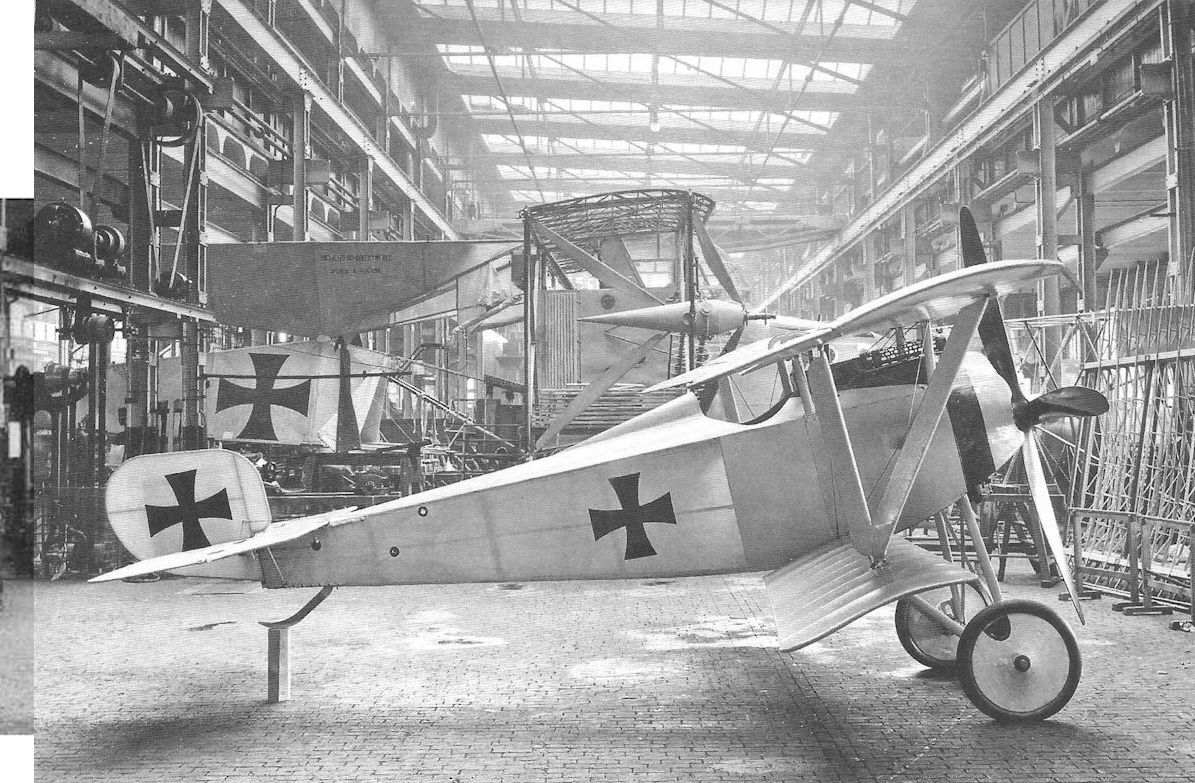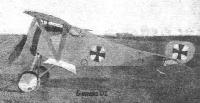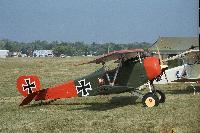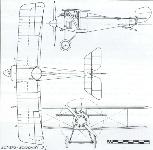
Описание
Страна: Германия
Год: 1916
Истребитель
Варианты
- Nieuport - Nieuport-11/16 Bebe - 1915 - Франция
- Nieuport - Nieuport-17/21/23 - 1916 - Франция
- Siemens-Schuckert - D.I - 1916 - Германия
- Nieuport - Nieuport-17bis/24/27 - 1917 - Франция
- В.Кондратьев Самолеты первой мировой войны
- O.Thetford, P.Gray German Aircraft of the First World War (Putnam)
- J.Herris Siemens-Schuckert Aircraft of WWI (A Centennial Perspective on Great War Airplanes 12)
- M.Dusing German Aviation Industry in WWI. Volume 2 (A Centennial Perspective on Great War Airplanes 85)
- W.Green, G.Swanborough The Complete Book of Fighters
- Журнал Flight
-
В.Кондратьев - Самолеты первой мировой войны
Опытный экземпляр истребителя "Сименс-Шуккерт" D.I, сентябрь 1916г.
-
J.Herris - Siemens-Schuckert Aircraft of World War I /Centennial Perspective/ (12)
SSW D.I 3506/16 of Jasta 7
-
J.Herris - Siemens-Schuckert Aircraft of World War I /Centennial Perspective/ (12)
SSW D.I 3760/16 of Jasta 14
-
J.Herris - Siemens-Schuckert Aircraft of World War I /Centennial Perspective/ (12)
SSW D.I 3761/16 of Jasta 5
-
В.Кондратьев - Самолеты первой мировой войны
"Сименс-Шуккерт" D.I, пилот Ханс фон Хуннербейн, апрель 1917г.
-
J.Herris - Siemens-Schuckert Aircraft of World War I /Centennial Perspective/ (12)
Прототип "Сименс-Шуккерта" D.I в заводском цехе
The prototype SSW D.I, 3503/16, in the factory with an R-plane under construction in the background.Другие самолёты на фотографии: Siemens-Schuckert R-II - R-VII - Германия - 1915
-
J.Herris - Siemens-Schuckert Aircraft of World War I /Centennial Perspective/ (12)
The prototype SSW D.I with four-bladed propeller and Sh.I engine. The machine gun is offset slightly to the right.
-
J.Herris - Siemens-Schuckert Aircraft of World War I /Centennial Perspective/ (12)
The prototype SSW D.I, 3503/16, wears small Eiserneskreuz markings on the upper wings reminiscent of the E.I marking style. At right appears to be a Nieuport 16 fuselage and engine cowl.
Другие самолёты на фотографии: Nieuport Nieuport-11/16 Bebe - Франция - 1915
-
J.Herris - Siemens-Schuckert Aircraft of World War I /Centennial Perspective/ (12)
The prototype SSW D.I, 3503/16, at Doberitz with designer and test pilot Bruno Steffen, the D.I designer's brother. The Sh.I counter-rotary was powerful and its propeller was slow-turning, resulting in a large propeller diameter and tall undercarriage when a two-blade propeller was fitted. The Sh.I required bearing supports at the front of the cowling. There is no carburetor intake scope on the port side.
-
J.Herris - Siemens-Schuckert Aircraft of World War I /Centennial Perspective/ (12)
The prototype SSW D.I, 3503/16, shows its carburetor intake scoop on the starboard side and no side vents on the engine cowling.
-
J.Herris - Siemens-Schuckert Aircraft of World War I /Centennial Perspective/ (12)
The first six SSW D.I on the SSW factory airfield at Nurnberg. Only the second aircraft in line has the three-color camouflage used on some of the aircraft.
The Fokker Scourge that had lasted nine months or so came to an end in the late spring of 1916, with the mass advent of the fast and agile Nieuport 17, for which the Eindeckers were no match. As was inevitable, an intact example of the Nieuport fell into German hands fairly soon after its debut. The German reaction was interesting. As quickly as possible the aircraft was stripped and engineering drawings produced. These, along with requests for tenders to produce a copy were issued to industry. Euler and Siemens-Schuckert Werke were the two companies selected to build this back-engineered version of the Nieuport. Depicted here is a line-up of five Siemens-Schuckert Werke D Is, fresh from final assembly, at the company's Nuremburg facility. Markedly inferior in performance to the original, the single seat D I used a 110hp Siemens Sh I rotary, giving a top level speed of 97mph at 6,560 feet. Originally, orders for 250 D Is had been placed with the firm, but these were progressively cut back to 94 by the spring of 1917. The D I was mainly delivered to the Eastern Front, being generally considered inferior to the newly developed Albatros D III. -
J.Herris - Siemens-Schuckert Aircraft of World War I /Centennial Perspective/ (12)
SSW D.I fighters probably at the factory.
-
J.Herris - Siemens-Schuckert Aircraft of World War I /Centennial Perspective/ (12)
These photos of a number of SSW D.I fighters were probably taken at the factory; no Jasta ever had this many SSW D.I aircraft assigned to it.
-
J.Herris - Development of German Warplanes in WWI /Centennial Perspective/ (1)
SSW D.I (D.3513/16) with Sh I and Wotan propeller.
SSW D.I 3513/16, an early production machine, wears the three-color camouflage scheme and carries large Eiserneskreuz markings on white fields underneath the upper as well as the lower wings. The large propeller needed to absorb the power from the slow-turning 110 hp Sh.I engine is prominent. -
J.Herris - Siemens-Schuckert Aircraft of World War I /Centennial Perspective/ (12)
An early-production SSW D.I with no spinner and four cooling louvers on the fuselage side.
-
J.Herris - Siemens-Schuckert Aircraft of World War I /Centennial Perspective/ (12)
This SSW D.I was assigned to Jasta 5. From the delivery data, this is probably 3761/16 shipped on April 25, 1916. A cloth covering protects the propeller and no spinner is fitted, probably because of the protective cloth covering.
-
J.Herris - Siemens-Schuckert Aircraft of World War I /Centennial Perspective/ (12)
SSW D.I 3511/16, an early production machine, in slightly different views. The white rectangle under the cockpit carries the rigging instructions. This aircraft was sent to Jasta 11 via Armeeflugpark 6 on May 7, 1917,for Lt. Karl Emil Schafer. Schafer had 25 victories at the time and had been awarded the Pour le Merite. Schafer increased his score to 30 before being killed in action on June 5.
-
J.Herris - DFW Aircraft of WWI /Centennial Perspective/ (29)
The DFW R.I 11/15 in its final form. The machine in the foreground is a SSW D.1 fighter.
Другие самолёты на фотографии: DFW R.I/R.II - Германия - 1916
-
J.Herris - DFW Aircraft of WWI /Centennial Perspective/ (29)
The DFW R.I is its final configuration is joined by an SSW D.I fighter to provide a size comparison. The R.I has full camouflage paint and all the other upgrades. The massive DFW R.I was a 'canvas overcast'. (Peter M. Grosz Collection/SDTB)
Другие самолёты на фотографии: DFW R.I/R.II - Германия - 1916
-
J.Herris - DFW Aircraft of WWI /Centennial Perspective/ (29)
The DFW R.I in its final configuration with fixed rudder and larger rudders. An SSW D.I is parked in front of the R.I to provide a size comparison.
Другие самолёты на фотографии: DFW R.I/R.II - Германия - 1916
-
Журнал - Flight за 1918 г.
The Siemens Single-Seater. From the fact that It is said to be the type D I, and a publication of the illustration in a German paper has been allowed, it appears improbable that this is one of the Siemens-Schuckert machines of which a good deal in now heard are seen on the Western Front. The machine has a distinctly "Nieuporty" appearance.
-
J.Herris - Siemens-Schuckert Aircraft of World War I /Centennial Perspective/ (12)
SSW D.I 3506/16 was shipped to Jasta 7 on Feb. 16, 1917.
-
J.Herris - Siemens-Schuckert Aircraft of World War I /Centennial Perspective/ (12)
Один из "сименс-шуккертов" D.I на заснеженном полевом аэродроме / Siemens-Schuckert D.I (serial 3506/17) of Jasta 7.
A mid-production SSW D.I serving with Jasta 7 sports a spinner. Together with the reduced gap, the spinner gives the D.I a more aggressive look than the Nieuport 17 on which it was based. The Sh.I counter-rotary engine required a large propeller due to its low propeller RPM, which was more efficient and gave a good climb rate. -
J.Herris - Siemens-Schuckert Aircraft of World War I /Centennial Perspective/ (12)
Another view of SSW D.I 3506/16 at Jasta 7 in February 1917. The slow-turning Sh.I counter-rotary engine required a large diameter propeller for best efficiency, which in turn required a taller landing gear than the Nieuport 17 on which its design was based. The propeller spinner was also different in shape than the fixed, hemispherical cone of penetration fitted to a few Nieuports.
-
J.Herris - Siemens-Schuckert Aircraft of World War I /Centennial Perspective/ (12)
This SSW D.I appears to be in service at the front but could be at a flying school.
-
J.Herris - Siemens-Schuckert Aircraft of World War I /Centennial Perspective/ (12)
SSW D.I 3761/16, with spinner now fitted, was assigned to Jasta 5. Lt. Kurt Schneider is in the cockpit.
-
J.Herris - Siemens-Schuckert Aircraft of World War I /Centennial Perspective/ (12)
SSW D.I 3767/16 was one of the last D.I fighters built and was sent to the Flugzeugmeisterie at Adlershof along with five other D.I fighters and D.Ia 3768/16. The upper wing was close to the fuselage to provide the pilot with a good field of view over the wing. The small gap, the headrest, and the large propeller with sizable spinner all gave the SSW D.I a more aggressive look than the Nieuport on which it was based. The tail skid differed from that on early machines.
-
J.Herris - Siemens-Schuckert Aircraft of World War I /Centennial Perspective/ (12)
"Сименс-Шуккерт" D.I в двухцветном коричнево-зеленом камуфляже.
Representing an attempt to improve the basic D I design, the D Ia featured an increase in wing area and a twin-gun armament. -
J.Herris - Siemens-Schuckert Aircraft of World War I /Centennial Perspective/ (12)
Another view of SSW D.I 3761/16 at Jasta 5 with Hptm. Hans von Huhnerbein in the cockpit.
-
J.Herris - Siemens-Schuckert Aircraft of World War I /Centennial Perspective/ (12)
SSW D.I airframes 3524/16, 3525/16, 3534/16, and others being painted at the SSW factory at Nurnberg in 1916. Aircraft in the foreground have the four-louver engine panel while those in the background have the later panel with three louvers. Camouflage is the three-color scheme. The interior views show the factory was clean and modern for 1916.
-
J.Herris - Siemens-Schuckert Aircraft of World War I /Centennial Perspective/ (12)
SSW D.I fuselages being built at the SSW factory at Nurnberg in 1916.
-
J.Herris - Siemens-Schuckert Aircraft of World War I /Centennial Perspective/ (12)
This SSW D.I crashed at the SSW factory, fortunately with less dramatic results than the crash of D.I 3761/16.
-
J.Herris - Siemens-Schuckert Aircraft of World War I /Centennial Perspective/ (12)
This SSW D.I assigned to Jasta 14 apparently suffered a bad landing. From the delivery data this could be 3505/16 or possibly 3760/16.
-
J.Herris - Siemens-Schuckert Aircraft of World War I /Centennial Perspective/ (12)
The smoldering remains of SSW D.l 3761/16 after being fatally crashed by Hptm. Hans von Huhnerbein at Jasta 5 at Boistrancourt airfield on May 7, 1917, during a test flight. Huhnerbein was Staffelfuhrer of Jasta 5 and had scored his only victory on April 7, 1917, ironically over a Nieuport 17.
-
J.Herris - Siemens-Schuckert Aircraft of World War I /Centennial Perspective/ (12)
SSW D.I rigging diagram.
-
J.Herris - Siemens-Schuckert Aircraft of World War I /Centennial Perspective/ (12)
Initial SSW D.II design based on the D.I; This aircraft was not built.
-
J.Herris - Siemens-Schuckert Aircraft of World War I /Centennial Perspective/ (12)
Initial SSW D.IIb design based on the D.I; This aircraft was not built.
В.Кондратьев Самолеты первой мировой войны
"СИМЕНС-ШУККЕРТ" SSW D.I / SIEMENS-SCHUCKERT SSW D.I
Появление на западном фронте в начале 1916 года новых французских истребителей "Ньюпор-11" вызвало серьезное беспокойство у немецкого авиационного командования. Вражеские самолеты по всем статьям превосходили монопланы "Фоккер" и "Пфальц", составлявшие в то время основу германской истребительной авиации. Авиафирмам был выдан срочный заказ на создание боевых самолетов с более высокими летными характеристиками. Инженеры фирмы "Сименс-Шуккерт Верк" (SSW) в ответ не придумали ничего лучшего, чем просто скопировать французскую машину, оснастив ее более мощным мотором собственной разработки.
Так в сентябре 1916-го появился "Сименс-Шуккерт" D.I, которой являлся почти точной копией "Ньюпора" с незначительными изменениями. В частности, межкрыльевые стойки у него изготовлялись не из дерева, а из стальных труб с алюминиевыми обтекателями.
Но главное отличие заключалось в силовой установке. На "Сименс-Шуккерте" стоял так называемый биротативный мотор "Сименс-Хальске" SH.I мощностью 110 л.с. Коленвал и винт у этого звездообразного мотора воздушного охлаждения вращались при работе в одну сторону, а картер с цилиндрами - в противоположную.
Преимущество столь оригинальной конструкции заключалось в том, что она позволяла передавать на винт больше мощности при меньшем числе оборотов. Благодаря этому становилась возможной установка винтов увеличенного диаметра с повышенным КПД.
Кроме того, биротативный принцип обеспечивал лучшие условия охлаждения цилиндров и снижал центробежные нагрузки на картер. Однако при этом мотор получился гораздо сложнее и тяжелее ротативного и не отличался высокой надежностью.
Испытания показали, что летные данные "Сименс-Шуккерта" в целом выше, чем у трофейных "ньюпора-11" и "ньюпора-16". 25 ноября 1916 г. Фирма получила заказ на 150 серийных экземпляров, а в декабре началась их сборка на заводах в Берлине и Нюрнберге.
Однако к тому времени уже выпускались и поступали в войска "альбатросы", которым "Сименс-Шуккерт" уступал практически по всем показателям. "Альбатрос" D.III был быстрее, скороподъемнее и вдвое лучше вооружен, поскольку на "Сименс-Шуккерте" стоял только один синхронный пулемет. В результате в марте 1917-го, после постройки 95 экземпляров "Сименс-Шуккерта", заказ был аннулирован и от дальнейшей постройки отказались.
Большинство уже построенных копий "Ньюпора" распределили по летным школам, но часть из них попала и во фронтовые подразделения. Никаких боевых успехов за этими машинами не числилось, и сколько-нибудь заметного следа в истории они не оставили.
ЛЕТНО-ТЕХНИЧЕСКИЕ ХАРАКТЕРИСТИКИ
Размах, м 7,5
Длина, м 6,9
Площадь крыльев, м2 14,4
Сухой вес, кг 430
Взлетный вес, кг 635
Скорость максимальная, км/ч 155
Время набора высоты
2000 м, мин. 8,0
Потолок, м 5000
Описание:





















































